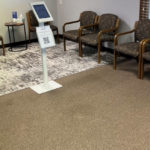
The virtual check-in point in one of Dr. Fleming’s practice offices. He says that virtual check-in is easy for patients to adapt to because they are used to doing it in other businesses, and it is a great efficiency booster for a practice.
By Chad Fleming, OD, FAAO
Nov. 30, 2022
Great practice management and business ideas often come from beyond the optical industry. Here are few ideas I picked up from outside of optometry that have increased our profitability and reduced our cost of goods sold (COGS).
Virtual Check-In
Like many of you, I experienced this approach to checking in and out, via a kiosk, in multiple places, such as Walmart and the local Department of Motor Vehicles. I was struck by how much more efficient the check-in process was when handled this way, and also, how fast people got used to this new way of doing it.
To adapt this approach to my own office, I transitioned our front-desk receptionist into a communication specialist who works with phone, texting and e-communications. The need for checking in seemed like something we could train patients to do on their phone or on an iPad we would provide to them. We felt that we could do this without the use of kiosks.
Having patients check in virtually reduces the need to increase staff. Automating processes like this in our office enables us to become less dependent on employees, who can be hard to recruit and undependable in how long they stay with us. It also allows us to reduce our payroll expenses.
The hardest part of accomplishing this change was convincing the fellow members of our leadership team of owners and managers that this was a good idea. The frustration with staff turnover made my argument compelling.
Thanks to virtual check-in, we were able to repurpose a staff person instead of hiring a second one, freeing that person’s time up to do tasks in the office, such as working more with patients in the optical or helping with pre-testing, which they could not do when so much of their time was tied up with the check-in process.
I estimate that we saved the cost of half a front desk staff member, which adds up to $13,000 annually.
The patient experience has not been adversely affected by this change, and may even have benefited from it. Everyone in our office knows when a patient checks in because we all have access to a spreadsheet that is updated in real time, so when “Mrs. Smith” checks in for an appointment, there is no chance she will be neglected.
Virtual check-in is a paradigm shift, but your future profitability depends on your ability to innovate and implement technology that makes you leaner and more efficient.
Other Articles to Explore
Selling While Keeping Inventory Investment Extremely Low
Cash flow is king…inventory is expensive. If you can sell without keeping inventory, you will capture more profits. This point was driven home for me by the CEO Warrior Podcast with Mike Agugliaro.
I began this transition by selling down all the frames that we had purchased. I then replaced our old, conventional frame-board management approach with a system that could outfit my boards with a 90 percent frame model (new term for consignment).
My goal was to increase cash flow and not lose money due to inventory idling on our board. Sitting inventory is a loss for a practice, and inflation only magnifies that loss.
Even the process of making this change was profitable for us. We generated $60,000 per each of our three offices because we sold the frame inventory and replaced it with inventory that cost us nothing until it was sold.
We experienced a huge year of profits when we first made this inventory management change, and now we have so much less money tied up in inventory that we run leaner. Our COGS run at 20 percent of net revenues or less.
Patients win too in customer service, as the turnaround time for completed eyewear with our new system is five business days for most frames and lenses, whether paid for out-of-pocket or via a managed vision care plan.
Our chief financial officer and our practice CPA told us we are incredibly smart for making this change, and asked if most optometry practices operate this way. They were surprised when we told him that most OD practices still manage inventory the old way.
Don’t be afraid to change to a new way of doing things that has already been proven to be better than the way you are now operating.
Having an In-House Frame Brand
I noticed that companies like Cabela’s-Bass Pro Shop, Amazon and Best Buy, and many others, offer proprietary brands. I wondered why we shouldn’t do the same in our practice. We need to compete with Warby Parker branding and the value proposition that other companies like Costco and Sam’s Club are offering to patients.
We invested in a bundle of frame and lenses via the same company we use to operate without a frame inventory investment, and marketed it all together under one name to consolidate the glasses purchase as “our in-house brand.” The investment costs us $179 monthly with no additional investment until the inventory sells.
Having an in-house brand, which can compete on price against most large retailers, increased eyewear sales each year for three years by 25 percent when we first made this change. We now sell approximately 1,200-1,500 of these in-house brand glasses (includes all lenses and treatments) annually. Purchases via our proprietary brand are cash-only. If a patient has a managed vision plan, they can choose from 600 of our other frames on the board.
Patients now ask for our in-house brand by name, as they have been trained to understand that Wichita Optometry has a great value proposition with our in-house brand. Consumers value in-house (private label) brands at major stores like Amazon, Best Buy and Cabela’s-Bass Pro Shops. And now they value ours.
Most ODs who struggle to be profitable, and I mean profitable after paying ALL doctors in their practice, need to take the risk of implementing and executing ideas like adding an in-house brand. You need to do things like this that give your practice a value proposition that allows you to hold your own against much larger competitors.
 Chad Fleming, OD, FAAO, is a partner with Wichita Optometry, P. A. in Wichita, Kan. To contact: chad@optometryceo.com
Chad Fleming, OD, FAAO, is a partner with Wichita Optometry, P. A. in Wichita, Kan. To contact: chad@optometryceo.com

























